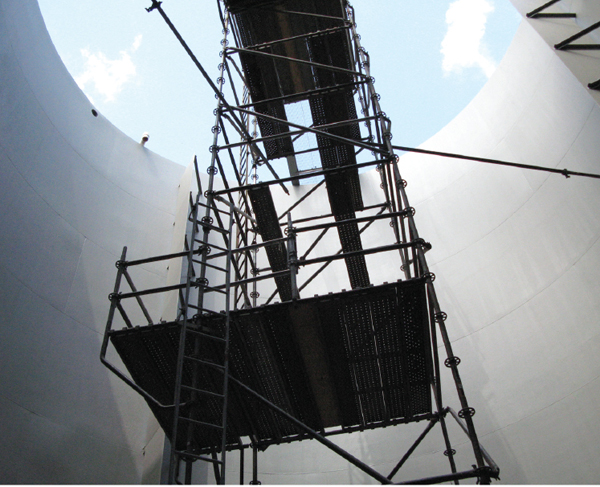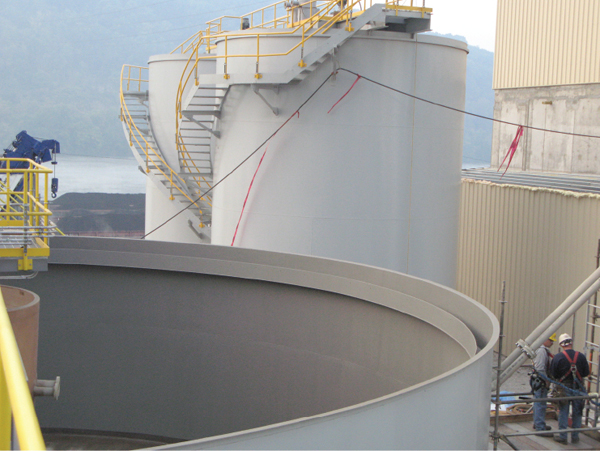Advanced Coatings Protect Plant FGD Systems
Now that many flue gas desulfurization (FGD) systems are reaching middle age, corrosion repairs of structural and process vessels are becoming more common. Corrosion is caused by condensates of acids formed during the FGD process, which accelerate pitting and crevice corrosion, particularly in scrubbers where high sulfate solutions are present. Scrubbers lined with 2205 duplex stainless steel are among the most vulnerable to pit or crevice corrosion, from both chlorides and fluorides.
An article in the Pittsburgh Post-Gazette (“Cheswick power plant gets OK to run during repairs,” December 17, 2010) reports severe FGD corrosion problems at GenOn Energy’s 570-MW Cheswick coal-fired plant, located 18 miles northeast of Pittsburgh. Problems found during an October 2010 outage spurred the utility to request permission to operate the plant without its scrubbers while repairs to the FGD system were completed.
Another report suggests that FGD corrosion problems are much more widespread than first thought: “The corrosion problem in the scrubber vessel has occurred at as many as 70 other power plants across the country and appears to be caused by the type of metal alloy used for that part of the equipment. GenOn will install protective liners and coatings to correct the problem and expects to have those repairs finished by early March [2011],” according to writer Don Hopey (Figure 1).
 |
| 1. Corrosion is the culprit. According to one report, more than 70 plants are facing problems with corrosion to flue gas desulfurization tank linings constructed of 2205 stainless steel and C276 Hastelloy. However, those problems can be prevented using vinyl ester coatings that are resistant to chemicals, abrasion, and water permeation. Courtesy: KCC Corrosion Control |
According to a Dec. 7, 2010, GenOn letter to the Allegheny County Health Department, the emissions control equipment was installed in June 2010 but was so severely corroded after only four months of operation that it couldn’t be used, the article says. After a two-month shutdown, the county health department agreed to let the Cheswick power plant resume operation without the scrubber through March 31, 2011, when the repairs were completed.
Pervasive Problems
In fact, scrubber corrosion failures may be far more common than the 70 problematic plants cited in the article, says Art Rak, CEO of Ultimate Corrosion Control (UCC). He attributes much of the problem to the use of 2205 duplex stainless steel for FGD linings.
“While all FGD systems are somewhat different, over a 15-year history of working in the power plant market, abrasion, pit corrosion, and chlorides in FGD systems have commonly caused failures,” Rak says. “Given the potentially aggressive corrosive conditions present in FGD systems—dew point, acidity, high temperature, concentrations of chlorides and fluorides, wet-dry cycles and gas velocity—no two systems are exactly the same. When it’s all said and done, what is really needed is the combination of chemical, abrasion, and permeation resistance.”
Coatings Solution
Permeation-resistant coatings have worked well for UCC, which uses vinyl ester products called VE 62 and VE 62AR (a top coat), manufactured by KCC Corrosion Control. “The properties of this vinyl ester material have other significant advantages over other linings, especially its permeation resistance,” says Rak. “When tested in independent labs, the permeation and abrasion resistance is so extraordinary that it puts this design in the category as the leader in the market.”
Thomas Priest, KCC’s CEO, identified another dimension to the benefits of permeation resistance. “While we talk about chemicals and abrasives in a FGD system, what the industry should fear most is water vapor transmission,” according to Priest. “The water vapor transmission permeates through a polymer lining on steel or concrete substrates occurs due to interior tank temperatures being higher than exterior tank temperatures, setting up a pressure or ‘driving force’ to move water vapor through the lining, causing osmotic blisters on steel surfaces and star cracks on concrete surfaces.”
Permeation resistance of a polymer lining is the single greatest determinant of a lining system’s life expectancy. “KCC VE 62/VE 62AR was used to coat test panels that were installed in an FGD ductwork section (specifically the gas cooler) ahead of a part of a Chiyoda CT-121 FGD system,” says Bryan Louque, PE, of the Pipeline and Hazardous Materials Safety Administration. “The FGD unit served a 500-plus-MW power station located in the Midwest. Two other coatings that were tested: a troweled-on, thick film vinyl esters and a sprayed-on epoxy and vulcanized rubber compound. After six months of operation, the three VE 62 test coupons showed no visible signs of abrasion or delamination. One of the coupons was removed and DFT measurements obtained. The VE 62 DFT measurements obtained after six months of operation were essentially unchanged from the date of installation.”
Louque adds that KCC VE 62 exhibits excellent abrasion and chemical resistance for a spray-applied vinyl ester, based on its inherent abrasion resistance and adhesion to the base metal. Temperature performance is similar to that of other spray-applied vinyl ester systems.
Priest says that, in terms of permeation resistance, his firm’s vinyl ester coatings (VE 62 and VE 62AR) have moved the benchmark three decimal places. “Typical permeation occurs at 0.01 inches,” he explains (Figure 2). “Permeation of our vinyl ester coatings occurs at 0.0003 inches, another order of magnitude, and is virtually the most permeation-resistant lining in the world.”
 |
| 2. Seal the steel. Vinyl ester polymers such as KCC Corrosion Control’s VE 62 and VE 62 AR are spray-applied rather than trowel-applied, saving on labor time and reducing waste. Additionally, the vinyl esters significantly reduce water permeation, which typically occurs at 0.01 inches, but with these products only occurs at 0.0003 inches. Courtesy: KCC Corrosion Control |
Rak says that the vinyl ester coating’s design also provides very high performance when it comes to chemical and temperature resistance. “It is a spray-applied, vinyl ester polymer that is easier to apply while outperforming trowel-applied linings, which is what power plants have to install to even approach the same performance,” says Rak. “Also, trowel-applied linings consume great quantities of field labor and waste a lot of material (approximately 20% to 30% in overthickness) because a trowel is a very imperfect means of application and [it] is extremely difficult to obtain a uniform thickness that is easily obtained by an airless spray-on coating.”
Evidence of this savings and consistency, as well as dramatically lower VOC of styrene, is demonstrated by the vinyl ester (VE 62) coating’s normal thickness when spray applied: a 30-mil wet coat yields a 30-mil dry coat.
For even more abrasion resistance on high-impact areas in limestone slurry tanks and other high-abrasion environments, KCC has developed a top coat (VE 62AR) that Rak says scores very well in Taber abrasion tests: VE 62AR wears the CS17 wheels out on the test (ASTM D 4060) with no abrasion of the lining. “It can be installed for approximately 40% less than the cost of other, more traditional coatings,” Rak adds. He claims that VE 62 will last longer, while outperforming, in every way, other sprayed-on or troweled-on FGD linings.
—Contributed by KCC Corrosion Control (www.kcccontrol.com).